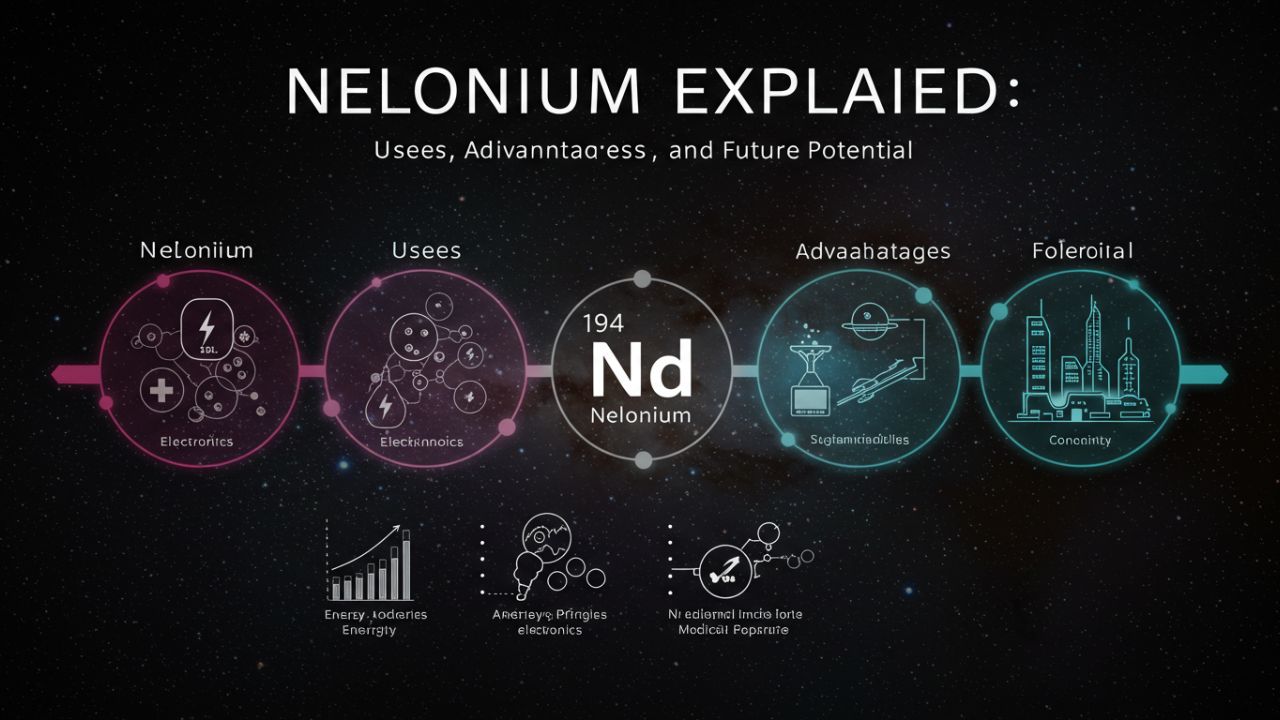Blog
Nelonium Explained: Uses, Advantages, and Future Potential

Introduction to Nelonium
Nelonium is making waves in the world of materials science, and for good reason. This innovative substance has emerged as a game-changer across various industries, from construction to technology. But what exactly is nelonium? How did it come to be, and why should you care about its potential? Join us on a journey through the fascinating realm of nelonium as we explore its history, applications, advantages, and what the future may hold for this remarkable material. Get ready to discover why nelonium could be the next big thing!
History and Development of Nelonium
The journey of nelonium began in the early 2000s, driven by a need for advanced materials. Researchers sought alternatives to traditional metals and polymers, aiming for something lighter yet robust. Through rigorous experimentation, scientists isolated nelonium from various compounds. Its unique molecular structure quickly caught attention within the materials science community. By 2010, promising results led to further studies on its properties. Nelonium exhibited remarkable strength-to-weight ratios and impressive thermal stability. These attributes made it suitable for diverse applications.
As development progressed, partnerships emerged between academic institutions and industries. This collaboration accelerated innovations in manufacturing techniques involving nelonium. Today, ongoing research continues to unlock new possibilities with this material. The quest to harness its full potential has only just begun as we explore what nelonium can achieve across multiple sectors.
Applications and Uses of Nelonium
Nelonium is making waves across various industries due to its versatile properties. In electronics, it serves as a crucial component in advanced circuitry. Its excellent conductivity ensures efficient energy transfer, which enhances device performance. The aerospace sector has also embraced nelonium for its lightweight yet durable nature. This material helps reduce the overall weight of aircraft without compromising structural integrity. In the realm of healthcare, nelonium shows promise in drug delivery systems. Its biocompatibility allows for safer transport of medications within the body.
Additionally, nelonium’s unique thermal resistance makes it ideal for applications involving high temperatures. Industries that require heat insulation can benefit significantly from this innovative material. Nelonium is gaining traction in renewable energy solutions too. It plays a vital role in improving solar panel efficiency and battery technology advancements.
Advantages and Benefits of Nelonium
Nelonium stands out for its remarkable versatility across various industries. One major advantage is its lightweight nature, which enhances efficiency in applications like aerospace and automotive engineering. Its resistance to corrosion makes nelonium ideal for environments that demand durability. This feature prolongs the lifespan of products, reducing maintenance costs significantly. In addition, nelonium’s excellent thermal conductivity ensures effective heat management in electronic devices. This property not only improves performance but also boosts energy efficiency.
Moreover, it’s eco-friendly and can be recycled easily. Manufacturers are increasingly looking for sustainable materials, making nelonium a prime candidate in green technology initiatives. The adaptability of nelonium allows it to be molded into complex shapes without compromising strength or integrity. This flexibility opens doors to innovative designs that were previously unattainable with traditional materials.
The Potential for Future Innovations with Nelonium
The future of nelonium is brimming with possibilities. Researchers are exploring its unique properties for cutting-edge applications in various fields. One potential area is renewable energy, where nelonium could enhance battery technology. Its lightweight nature and conductivity may lead to longer-lasting power sources. Another exciting frontier lies in the medical field. Nelonium has shown promise in biocompatibility studies, which means it might be suitable for implants or drug delivery systems.
Additionally, the aerospace industry sees value in this material’s strength-to-weight ratio, potentially revolutionizing aircraft design. As scientists delve deeper into its molecular structure, new uses could emerge that we haven’t yet imagined. The versatility of nelonium makes it a candidate worth watching as innovation progresses at an unprecedented pace.
Comparison to Other Materials
When comparing nelonium to traditional materials like steel or plastic, its lightweight nature stands out. This characteristic makes it ideal for applications that require efficiency without compromising strength. Unlike aluminum, which can corrode over time, nelonium offers enhanced durability. Its resistance to environmental factors ensures longevity in various settings. In contrast to composites, nelonium simplifies manufacturing processes. It’s easier to mold and shape, reducing production costs while maintaining quality.
Additionally, the thermal properties of nelonium make it suitable for high-temperature environments where other materials might fail. This versatility showcases its potential across industries such as aerospace and automotive. Nelonium’s unique blend of attributes positions it favorably against established materials in numerous applications. As more sectors explore its capabilities, the impact could reshape material science standards significantly.
Conclusion
Nelonium stands at the forefront of material science, bridging traditional uses with innovative applications. Its unique properties open doors to various industries, from electronics to healthcare. The historical development of nelonium showcases a journey filled with research and discovery that continues today.
As we explore its advantages, it’s clear that nelonium offers benefits like durability and sustainability over many conventional materials. This not only enhances product longevity but also aligns with growing environmental concerns.
Looking ahead, the future potential for nelonium is vast. As scientists and engineers delve deeper into its capabilities, new uses are likely to emerge, paving the way for groundbreaking developments across multiple sectors.
When compared to other materials currently in use, nelonium holds significant promise due to its versatility and performance characteristics. It’s an exciting time as we witness how this remarkable substance can revolutionize our approach to technology and manufacturing.
The possibilities surrounding nelonium are expanding rapidly, indicating a bright path forward for researchers and industry leaders alike. With ongoing advancements on the horizon, it’s worth keeping an eye on this innovative material as it reshapes our understanding of what modern materials can achieve.
Blog
Nolan Pentz Martinez and the Future of Creative Innovation

Introduction: Nolan Pentz Martinez and the Evolution of Digital Expression
In a world where technology constantly reshapes how art is made and consumed, Nolan Pentz Martinez stands out as one of the most inspiring names in the digital creative scene. Known for blending artistic imagination with technological innovation, Martinez’s work reflects the evolution of modern creativity. His approach to storytelling, design, and emotional expression has made him a rising figure among today’s generation of digital artists and creative thinkers.
Early Life and the Spark of Creativity
From a young age, Nolan Pentz Martinez showed an interest in exploring art through unconventional forms. Unlike traditional artists who rely solely on canvas or paper, Martinez gravitated toward digital mediums early on. Inspired by visual storytelling, film, and conceptual photography, he began experimenting with design software and motion tools that allowed him to translate his imagination into visual reality.
This early exposure to digital platforms helped shape his creative vision one that embraces technology as both a tool and a muse. His ability to merge emotion with modern design soon became a defining aspect of his artistic style.
The Rise of Nolan Pentz Martinez in the Digital Era
As the digital landscape expanded, Nolan Pentz Martinez leveraged social media and online portfolios to share his creations with a global audience. His visually captivating work often combining cinematic color tones, surreal imagery, and storytelling caught the attention of creative communities worldwide.
From personal projects to brand collaborations, Martinez began to gain recognition for his versatility and consistency. His art feels personal yet universally relatable, reflecting human emotion within futuristic themes. This unique signature helped him carve a distinct space in an industry overflowing with digital content.
Artistic Style and Vision of Nolan Pentz Martinez
What sets Nolan Pentz Martinez apart is his artistic philosophy the belief that creativity should always connect emotionally with people. He views each project as a visual conversation, where color, texture, and light work together to tell a story.
Martinez often explores topics like identity, technology’s influence on humanity, and the beauty of imperfection. His designs are known for their balance between realism and surrealism, making them thought-provoking and aesthetically powerful.
In his own words, creativity is not about perfection but expression. This mindset has made his art both distinctive and deeply human.
The Role of Technology in Nolan Pentz Martinez’s Work
Technology is more than a tool for Nolan Pentz Martinez it’s an extension of his imagination. He frequently experiments with AI-based design platforms, 3D modeling software, and advanced visual effects to create immersive digital art.
By integrating human emotion with machine precision, Martinez showcases how modern artists can coexist with technology rather than compete against it. His forward-thinking approach highlights the possibilities of merging art and innovation, making him a model for future creators navigating the intersection of creativity and computation.
Storytelling Through Visuals
At the heart of Nolan Pentz Martinez’s creations lies storytelling. Whether it’s a still image or a short animation, his work captures emotion in motion. Each piece invites viewers to look deeper, to interpret meaning, and to feel a connection.
He often uses symbolism reflections, shadows, and distorted imagery to represent internal emotions and human struggles. This narrative-driven method elevates his digital compositions from simple visuals to emotional experiences, which is why audiences resonate so deeply with his work.
Influence on Modern Creative Culture
Nolan Pentz Martinez represents a new wave of creators who are unafraid to challenge conventions. His art has inspired countless emerging designers, filmmakers, and digital storytellers to explore hybrid forms of expression.
Beyond his own work, Martinez contributes to creative education through online tutorials and digital workshops. His openness about his process from concept development to post-production has helped many young artists develop the skills and confidence to pursue their creative dreams.
He believes that knowledge should be shared, not guarded, and that collaboration is key to progress in the digital age.
The Future of Nolan Pentz Martinez’s Creative Journey
As he continues to evolve, Nolan Pentz Martinez shows no signs of slowing down. His upcoming projects reportedly explore immersive digital experiences, including virtual and augmented reality. These technologies allow him to transport viewers into his artistic worlds, offering fully interactive visual stories.
Martinez’s ability to adapt and innovate positions him as one of the most exciting creative voices of the decade. His journey reflects how artistry can grow with technology not lose its soul to it.
Lessons from Nolan Pentz Martinez for Aspiring Creators
For those entering the digital art world, the path of Nolan Pentz Martinez offers valuable insights:
-
Stay Curious: Innovation thrives on curiosity always explore new tools and methods.
-
Tell a Story: Every artwork should convey meaning, not just aesthetics.
-
Embrace Technology: Use digital tools to enhance creativity, not replace intuition.
-
Be Authentic: True success comes from staying genuine to your creative voice.
-
Keep Learning: The creative world evolves fast continuous growth keeps your art relevant.
Conclusion: The Legacy of Nolan Pentz Martinez
The creative world is witnessing a transformation and Nolan Pentz Martinez is at its forefront. His journey from a curious digital explorer to an influential creative figure is a testament to passion, innovation, and authenticity.
In his art, Martinez combines technology and emotion to remind us that creativity is limitless. His influence extends beyond visual beauty it’s a message to every artist that imagination, when paired with courage and curiosity, can change how the world sees art.
As the boundaries of digital creativity expand, one thing is clear: the story of Nolan Pentz Martinez has only just begun.
Blog
Sandy Goggins: A Modern Symbol of Leadership and Creativity

Introduction: The Inspiring Story of Sandy Goggins
In today’s world, where leadership and authenticity are highly valued, Sandy Goggins has emerged as a powerful example of how one person can inspire meaningful change. Through determination, creativity, and a forward-thinking mindset, Sandy Goggins has become a name associated with innovation, empathy, and personal growth. Whether through professional accomplishments or social contributions, Sandy continues to influence others with a strong sense of purpose and vision.
The journey of Sandy Goggins reflects modern ideals balancing success with compassion and achievement with integrity. From humble beginnings to making an impact across various industries, the story of Sandy Goggins shows how passion and persistence can shape a legacy that motivates others to strive for excellence.
Early Life and Background of Sandy Goggins
Every successful individual has a foundation built on experiences, challenges, and lessons learned along the way. For Sandy Goggins, that foundation began early in life with a deep curiosity and desire to create meaningful change. Growing up in an environment that encouraged learning and self-expression, Sandy developed a strong sense of responsibility and creativity.
Education played a significant role in shaping Sandy Goggins’ outlook. Instead of following traditional routes, Sandy explored diverse paths blending art, technology, and leadership to form a unique perspective. These early explorations became the cornerstone of a professional journey marked by innovation and resilience.
Sandy Goggins’ Career Journey and Achievements
The career of Sandy Goggins is a testament to what can be achieved with dedication and vision. From the start, Sandy focused on building a career centered on growth and innovation. By combining technical expertise with strong interpersonal skills, Sandy developed a reputation as a dynamic leader and creative thinker.
Over the years, Sandy has worked on multiple projects and initiatives that highlight adaptability and forward-thinking. Each success reflects a consistent drive to solve problems in new and efficient ways. Sandy Goggins is not just known for professional success but also for mentoring others and promoting collaboration.
A major factor behind this success is Sandy’s ability to recognize opportunities where others see challenges. This proactive mindset has turned obstacles into stepping stones, earning admiration from peers and communities alike.
Leadership Philosophy of Sandy Goggins
True leadership, according to Sandy Goggins, is rooted in empathy, understanding, and empowerment. Rather than focusing solely on authority or control, Sandy believes in nurturing potential and encouraging others to excel. This people-centered approach helps teams feel valued, motivated, and supported.
Sandy’s leadership style blends modern management strategies with genuine compassion. By listening to others, acknowledging their strengths, and providing constructive feedback, Sandy Goggins creates an environment where creativity and collaboration flourish. This balance between innovation and human connection is what sets Sandy apart as a modern-day leader.
In a time when many leaders focus only on results, Sandy reminds us that leadership is equally about trust, respect, and shared success.
Contributions to the Community
Beyond professional life, Sandy Goggins has made a meaningful impact through community service and social initiatives. Deeply passionate about giving back, Sandy has been involved in various outreach programs focused on education, sustainability, and youth development.
From sponsoring educational workshops to supporting charitable foundations, Sandy believes that progress is only valuable when it uplifts others. By dedicating time and resources to important causes, Sandy Goggins continues to make a difference at both local and global levels.
Sandy’s community work isn’t just about donations or appearances it’s about actively engaging with people, listening to their needs, and working together to create long-term solutions. This genuine approach to social responsibility has inspired many to follow in similar footsteps.
Personal Values and Motivations
At the heart of Sandy Goggins’ success lies a clear set of values: honesty, kindness, and perseverance. These guiding principles shape every decision and interaction. Sandy believes that personal growth and professional success go hand in hand when built upon integrity and compassion.
One of Sandy’s greatest strengths is staying grounded despite achievements. Through mindfulness and continuous self-reflection, Sandy maintains balance and purpose. This approach allows Sandy Goggins to stay focused on long-term goals while appreciating small milestones along the way.
When asked about motivation, Sandy often points to the power of human connection the belief that everyone has the potential to inspire change. This philosophy continues to influence not just career choices but also how Sandy interacts with the world.
Innovative Vision and Future Plans
Looking toward the future, Sandy Goggins envisions a world where technology, creativity, and human empathy come together to solve real-world problems. Sandy aims to continue exploring projects that blend innovation with social impact particularly in fields like education, sustainability, and digital transformation.
Sandy’s future goals include mentoring young professionals, expanding collaborative initiatives, and promoting diversity in leadership. The long-term mission is clear: to build a more inclusive and forward-thinking community that empowers people to succeed ethically and sustainably.
This forward-looking mindset shows that for Sandy Goggins, success is not the destination it’s the continuous journey toward improvement and positive influence.
Lessons from the Life of Sandy Goggins
The story of Sandy Goggins offers valuable lessons for anyone aspiring to make a difference in their field:
-
Stay Authentic: True success begins when you remain genuine to your values.
-
Lead with Empathy: Understanding others is the foundation of effective leadership.
-
Embrace Change: Innovation requires flexibility and curiosity.
-
Give Back: Success has deeper meaning when shared with others.
-
Keep Learning: Growth never stops; every experience adds to your wisdom.
These principles not only define Sandy Goggins’ journey but also serve as timeless advice for personal and professional development.
Conclusion: The Legacy of Sandy Goggins
The name Sandy Goggins stands as a reminder that leadership, compassion, and innovation can coexist beautifully. Through consistent dedication, creative thinking, and genuine care for others, Sandy has become a source of inspiration in a world that values authenticity more than ever before.
Sandy Goggins’ journey is proof that success is not measured by wealth or fame alone, but by the positive influence one leaves behind. As Sandy continues to inspire future generations, the message remains clear with passion, perseverance, and purpose, anyone can make a lasting impact.
Blog
Jane Elizabeth Abeloff: A Visionary in Education and Equality

Introduction: The Legacy of Jane Elizabeth Abeloff
When discussing individuals who have left a profound mark on education, equality, and community empowerment, Jane Elizabeth Abeloff stands among the most admired figures. Her name has become synonymous with compassion, innovation, and service to humanity.
Throughout her career, Jane Elizabeth Abeloff championed educational reform, social inclusion, and the belief that kindness combined with knowledge can reshape the world. Her contributions continue to inspire teachers, students, and leaders around the globe to work toward a fairer and more educated society.
Early Life and the Foundation of Purpose
Jane Elizabeth Abeloff’s story begins with curiosity and a natural desire to learn. Raised in an environment that valued empathy and education, she developed a sense of responsibility toward others early in life. Her formative years taught her that true progress comes from understanding people’s needs and creating opportunities for growth.
Her academic journey reflected both determination and vision. Jane Elizabeth Abeloff excelled in multiple disciplines literature, ethics, and sociology which helped her understand the human condition from different perspectives. Those insights later shaped her mission to create educational systems that serve everyone equally.
Jane Elizabeth Abeloff’s Impact on Education
Education became the cornerstone of Jane Elizabeth Abeloff’s career. She believed that learning was the most powerful weapon to eliminate inequality and transform societies. Her educational philosophy emphasized accessibility, inclusion, and lifelong curiosity.
Through her efforts, Jane Elizabeth Abeloff worked to make quality education available to communities that were often left behind. She collaborated with schools, organizations, and government programs to introduce mentorship initiatives, scholarship opportunities, and teacher-training systems designed to improve classroom experiences.
Her message was simple: “When you educate one person, you empower an entire community.” This belief continues to resonate with educators and policymakers today.
A Deep Commitment to Community Service
While Jane Elizabeth Abeloff was a pioneer in education, her humanitarian work extended far beyond classrooms. She was deeply engaged in community projects that addressed poverty, health, and women’s development.
Her hands-on approach made her stand out. Jane Elizabeth Abeloff didn’t just support causes financially she participated directly in fieldwork, listening to people’s struggles and helping craft practical solutions. Whether it was supporting literacy campaigns, building learning centers, or helping young women acquire vocational skills, her work always aimed to create self-sustaining communities.
Empowering Women and Promoting Equality
Another major pillar of Jane Elizabeth Abeloff’s legacy is her lifelong commitment to women’s empowerment. She recognized that empowering women was essential for achieving overall social and economic progress.
Her programs focused on leadership training, entrepreneurship, and equal access to education. Many of the women she mentored went on to become teachers, activists, and community leaders a testament to her lasting influence.
Jane Elizabeth Abeloff’s advocacy was grounded in action. She encouraged women to speak up, take charge of their futures, and build supportive networks. Her vision aligns with the modern global movement for gender equality that continues to gain momentum today.
Philanthropy Rooted in Empathy
Philanthropy was not a duty for Jane Elizabeth Abeloff it was a calling. She believed in giving not just wealth, but time, empathy, and energy. Her approach to charity was holistic: she aimed to address the causes of problems rather than just their symptoms.
From education funds to community health drives, Jane Elizabeth Abeloff dedicated her resources to projects that had measurable social impact. Her philanthropic principles were built on transparency and accountability, ensuring that every effort contributed directly to the betterment of lives.
Jane Elizabeth Abeloff’s Influence on Modern Thought
The influence of Jane Elizabeth Abeloff extends beyond her lifetime. Her philosophies continue to inspire modern educators, social workers, and thought leaders who believe in inclusive progress.
Many of today’s educational models particularly those emphasizing equal access and experiential learning echo her ideas. Non-profit organizations around the world still draw from her community-first approach, focusing on empathy-based leadership and sustainable development.
Even in the digital age, where education has moved online, her belief that “learning must remain human” is more relevant than ever. Her work serves as a reminder that technology should enhance empathy, not replace it.
Recognition and Lasting Tributes
In recognition of her life’s work, several institutions and foundations have created scholarships, awards, and educational initiatives in Jane Elizabeth Abeloff’s name. These honors continue to promote her ideals of equality, intellectual curiosity, and social progress.
Students who receive these scholarships often describe her story as a source of motivation a reminder that compassion combined with education can change the world.
Her name is now synonymous with service and intellectual excellence, inspiring countless individuals to continue her mission in their own ways.
Lessons from Jane Elizabeth Abeloff’s Life
Jane Elizabeth Abeloff’s journey provides timeless lessons that apply to everyone striving to make a difference:
-
Education is the great equalizer.
She believed knowledge must be accessible to all, regardless of background. -
Leadership means service.
Her leadership style was rooted in empathy and active participation. -
Empowerment begins with belief.
She showed that believing in others can help them unlock their potential. -
Legacy is built on action.
Through consistent service, Jane Elizabeth Abeloff created a legacy that outlives her.
These lessons remain as relevant today as they were during her lifetime, serving as guiding principles for educators and community builders.
Why Jane Elizabeth Abeloff’s Story Matters Today
In an age where societies are rapidly evolving, the principles Jane Elizabeth Abeloff stood for education, empathy, and equality have become essential once again. Her work demonstrates how genuine leadership and compassion can create change from the ground up.
Modern leaders, educators, and activists continue to draw inspiration from her approach to problem-solving combining strategic planning with deep human understanding.
By following her example, today’s changemakers can create systems that not only educate but also empower, ensuring that no one is left behind.
Conclusion: Carrying Forward the Vision of Jane Elizabeth Abeloff
The story of Jane Elizabeth Abeloff is not just a historical account it is a call to action. Her life proves that meaningful change begins with empathy and education.
She taught us that when people unite around compassion and knowledge, they can transform communities and generations. Her dedication reminds us that even one person’s vision can ignite a global movement of progress and understanding.
Today, as the world continues to face new challenges, her legacy lives on inspiring educators, students, and humanitarians to keep striving toward a brighter, fairer, and more compassionate future.
Blog
Lyric Beyoncé Hatch: Inside the Queen’s Songwriting Genius

Introduction: Understanding the Concept of Lyric Beyoncé Hatch
The phrase “lyric Beyoncé hatch” captures the essence of how Beyoncé gives life to her music. Every lyric she creates is carefully crafted, carrying emotional depth, storytelling, and cultural meaning. Beyoncé is more than a global superstar she’s a visionary songwriter whose words spark empowerment and reflection.
In 2025, Beyoncé’s lyrical creativity remains a driving force in music, setting new standards for authenticity and innovation. The lyric Beyoncé hatch represents her ongoing journey of turning emotion into art transforming thoughts and experiences into timeless lyrics that connect with millions across the world.
The Meaning Behind Lyric Beyoncé Hatch
The idea of lyric Beyoncé hatch can be seen as the “birth” of her lyrical expression where creativity meets purpose. Each song begins with inspiration drawn from personal stories, cultural roots, and social awareness.
For Beyoncé, lyrics aren’t just about rhythm or rhyme. They carry messages of identity, feminism, love, and resilience. Her songs like Halo, Formation, and Break My Soul highlight how every word she writes comes from an intentional creative process a true “hatch” of art and emotion.
How Beyoncé’s Lyrics Have Evolved Over the Years
1. The Early Era – Simplicity and Confidence
In the early 2000s, Beyoncé’s lyrics revolved around themes of self-confidence, independence, and love. Tracks like Crazy in Love and Me, Myself and I showcased her young spirit and determination. The lyric Beyoncé hatch during this time focused on fun, relatable messages that reflected her personal growth and ambition.
2. The Artistic Transformation – Truth and Vulnerability
As her career progressed, albums like 4 and Beyoncé (2013) revealed deeper layers of emotion. Her lyrics became more experimental and self-reflective. The lyric Beyoncé hatch process turned inward, allowing her to express vulnerability and strength simultaneously.
3. The Cultural Renaissance – Power and Identity
With Lemonade and Renaissance, Beyoncé’s lyric writing reached a new level of cultural influence. Her words began addressing race, gender, empowerment, and freedom. Each lyric she hatched carried social weight encouraging pride, unity, and awareness.
Inside the Lyric Beyoncé Hatch Process
1. Inspiration from Real Experiences
Beyoncé’s writing often begins with real emotion whether joy, heartbreak, or empowerment. Her lyrics in Lemonade, for example, reflect her personal journey through pain, forgiveness, and growth. The lyric Beyoncé hatch process starts with truth, making her songs deeply relatable.
2. Collaboration and Collective Creativity
Beyoncé collaborates with leading songwriters and producers to refine her lyrical vision. Her creative “hatch” isn’t solitary it’s a blend of voices and perspectives that shape each song’s final message. This teamwork helps maintain a perfect balance between emotional depth and commercial appeal.
3. Lyrical Symbolism and Storytelling
A hallmark of the lyric Beyoncé hatch is her symbolic approach. Every line holds meaning beyond its surface often linked to culture, spirituality, or identity. Her use of metaphors and visual imagery makes her lyrics resonate on multiple levels.
Examples of Lyric Beyoncé Hatch in Her Most Powerful Songs
“Formation” – The Birth of Empowerment
In Formation, Beyoncé celebrates Black culture and heritage while addressing social issues. This song perfectly captures the lyric Beyoncé hatch concept transforming cultural pride into an anthem of unity and strength.
“Halo” – A Poetic Declaration of Love
Halo is one of Beyoncé’s most emotional ballads, with lyrics that express purity and vulnerability. The simplicity of words like “I can see your halo” shows how her lyrical hatching process turns pure emotion into universal connection.
“Break My Soul” – Freedom and Reinvention
Released during a time of global uncertainty, Break My Soul encourages resilience and liberation. The lyric Beyoncé hatch here reflects her personal and artistic rebirth inspiring listeners to rebuild and rediscover themselves.
The Cultural and Emotional Power of Beyoncé’s Lyrics
The influence of lyric Beyoncé hatch extends beyond the music charts. Her lyrics have sparked academic discussions, inspired social movements, and given voice to underrepresented communities.
She uses her platform to challenge stereotypes, celebrate Black identity, and empower women globally. The combination of poetic lyrics and powerful messages makes her work timeless. Each “hatch” of words holds meaning for listeners navigating love, struggle, and self-discovery.
Beyoncé’s Lyric Hatch in the Digital Age (2025 Perspective)
In 2025, the way we consume music has changed from streaming platforms to AI-driven playlists. Yet Beyoncé’s lyrical depth continues to stand out in an era often dominated by short-form trends.
Her creative process adapts to new technology, but the lyric Beyoncé hatch remains rooted in human emotion. Even as she experiments with digital production, her words keep their authenticity, proving that true artistry transcends platforms and algorithms.
Beyoncé’s lyrics in recent years have also begun addressing modern challenges mental health, self-worth, and cultural preservation. Her songs remain a guiding voice for those seeking empowerment in an ever-changing world.
What Makes Lyric Beyoncé Hatch Unique
-
Authenticity: Every line comes from a genuine place of emotion or experience.
-
Empowerment: Her lyrics consistently uplift and motivate listeners.
-
Versatility: Beyoncé can move seamlessly between love ballads, protest songs, and dance anthems.
-
Symbolism: The lyric Beyoncé hatch often uses visual and poetic language that creates lasting impact.
-
Evolution: She constantly reinvents her writing style to match her growth and the world around her.
The Future of Lyric Beyoncé Hatch
As Beyoncé continues her artistic journey, fans eagerly anticipate how her lyrical themes will evolve. Rumors suggest she’s exploring global sounds and deeper storytelling in upcoming projects.
The lyric Beyoncé hatch will likely reflect a fusion of global influences, spirituality, and personal introspection. Whatever she creates next, it’s certain to blend emotional honesty with artistic excellence a hallmark that has defined her career for over two decades.
Conclusion: The Endless Evolution of Lyric Beyoncé Hatch
The concept of lyric Beyoncé hatch goes far beyond writing songs it represents the birth of ideas that transform music and culture. From early pop hits to revolutionary works like Lemonade and Renaissance, Beyoncé has proven that her lyrics can both entertain and enlighten.
Her words empower generations to stand tall, love deeply, and embrace their truth. The lyrical hatching process that began decades ago continues to inspire millions, proving that Beyoncé’s artistry is timeless and her creative voice, unstoppable.
Blog
Tasha Jacoby-Araujo: Inspiring a New Era of Leadership

Introduction: The Rise of Tasha Jacoby-Araujo
In the modern era of leadership and innovation, Tasha Jacoby-Araujo has emerged as a powerful voice advocating for empowerment, equality, and sustainable progress. Her story is not just about personal success it’s about creating meaningful change that uplifts others. Known for her dynamic leadership style and commitment to excellence, Tasha Jacoby-Araujo continues to shape conversations around diversity, leadership, and growth.
Whether in business, education, or community advocacy, her influence demonstrates that success is rooted in empathy, purpose, and a clear vision for the future.
Early Life and Education of Tasha Jacoby-Araujo
Every great leader begins with humble beginnings, and Tasha Jacoby-Araujo is no exception. From an early age, she displayed a deep curiosity about people, innovation, and leadership. Her academic journey focused on understanding systems how individuals, teams, and organizations work together to achieve common goals.
Through continuous learning and professional development, she built a strong foundation that allowed her to combine creativity with strategy. This balance became a defining trait in her career, helping her navigate challenges while inspiring others to grow.
Her upbringing instilled values of honesty, hard work, and perseverance qualities that continue to guide her in all her endeavors.
Professional Growth: How Tasha Jacoby-Araujo Built Her Influence
The career path of Tasha Jacoby-Araujo reflects a clear blend of vision, leadership, and innovation. She has held diverse roles across multiple sectors, each contributing to her depth of experience and understanding of organizational growth. Her ability to lead with empathy and strategy has made her a sought-after figure in both corporate and community circles.
Unlike traditional leaders who rely solely on authority, Tasha Jacoby-Araujo believes in collaborative success. She promotes open dialogue, creative problem-solving, and team empowerment. This inclusive leadership model allows her teams to thrive while achieving exceptional results.
Her strategic thinking, paired with her people-centered approach, continues to redefine what leadership means in the 21st century.
Leadership Philosophy of Tasha Jacoby-Araujo
For Tasha Jacoby-Araujo, leadership is not about being in charge it’s about taking care of those in your charge. She leads by example, showing that integrity and compassion can coexist with productivity and progress. Her philosophy revolves around three key principles:
-
Authentic Leadership – Staying true to one’s values while remaining transparent in decision-making.
-
Empowerment Through Collaboration – Building trust and encouraging participation at every level.
-
Continuous Learning – Viewing every experience, whether success or failure, as an opportunity to grow.
This mindset allows Tasha Jacoby-Araujo to foster innovation while maintaining a human-centered culture, where people feel seen, valued, and inspired.
Contributions and Achievements of Tasha Jacoby-Araujo
Over the years, Tasha Jacoby-Araujo has made notable contributions to leadership development, organizational transformation, and empowerment initiatives. Her impact can be seen in the way she mentors others, implements inclusive policies, and drives change in the communities she serves.
Her work often focuses on creating opportunities for underrepresented groups and promoting gender balance in leadership roles. By advocating for equal access to education and professional development, she continues to champion the belief that diversity is a strength not a challenge.
Her forward-thinking approach has inspired businesses, educators, and social organizations to adopt more ethical, inclusive, and innovative practices.
Challenges and Triumphs: Lessons from Tasha Jacoby-Araujo’s Journey
No leader’s story is complete without challenges, and Tasha Jacoby-Araujo has faced her share of them. Early in her career, she encountered barriers that tested her resilience and determination. Instead of letting those obstacles define her, she used them as stepping stones toward growth.
Her ability to stay composed under pressure and adapt to changing circumstances became one of her strongest qualities. She learned that success is not about avoiding difficulties but learning how to rise above them.
This mindset has made Tasha Jacoby-Araujo a role model for aspiring leaders who want to make a difference in their own careers.
Tasha Jacoby-Araujo’s Commitment to Empowerment and Diversity
A core part of Tasha Jacoby-Araujo’s mission is promoting empowerment through diversity and inclusion. She believes that a truly successful organization or community is one where everyone has a voice and an opportunity to thrive.
Her advocacy includes supporting mentorship programs, leadership training for women, and initiatives that encourage equality in the workplace. She emphasizes that empowerment begins with education by providing access to knowledge, we create pathways for individuals to reach their full potential.
Through her actions and words, Tasha Jacoby-Araujo has proven that empowering others does not diminish one’s own success it multiplies it.
Vision for the Future: What’s Next for Tasha Jacoby-Araujo
Looking ahead, Tasha Jacoby-Araujo remains committed to driving innovation, mentorship, and social impact. Her vision for the future involves building stronger bridges between technology, education, and community development.
She advocates for leadership that adapts to change without losing sight of human connection. As the world continues to evolve through digital transformation, her insights into ethical leadership and sustainable growth become increasingly valuable.
Her long-term goal is clear to create lasting change by inspiring future generations to lead with courage, empathy, and integrity.
Why Tasha Jacoby-Araujo Inspires a New Generation of Leaders
The influence of Tasha Jacoby-Araujo reaches far beyond her professional accomplishments. She represents a new era of leadership one that values inclusivity, emotional intelligence, and collaboration.
Aspiring leaders are drawn to her authenticity and humility. Her story reminds us that leadership isn’t about titles but about impact. She shows that with vision, perseverance, and kindness, anyone can lead in their own way.
In a time when the world needs more empathy and innovation, Tasha Jacoby-Araujo stands as a beacon of hope and inspiration.
Conclusion: The Enduring Legacy of Tasha Jacoby-Araujo
In conclusion, Tasha Jacoby-Araujo is more than a leader she’s a catalyst for change. Her journey from ambition to achievement reflects a balance of intelligence, compassion, and vision. Through her work, she has redefined what leadership means in the modern age, showing that real progress is built on authenticity and empowerment.
Her influence will continue to shape conversations about equality, leadership, and innovation for years to come. Tasha Jacoby-Araujo exemplifies that true success lies not in personal gain but in the ability to inspire others to reach their fullest potential.
Blog
Trevor Wakefield’s Secrets to Leadership and Growth

Introduction – The Rise of Trevor Wakefield
In today’s fast-changing digital world, few names capture the essence of modern innovation like Trevor Wakefield. Known for his creative mindset, tech-driven strategies, and unwavering focus on ethical entrepreneurship, Trevor Wakefield has emerged as a symbol of what it means to lead with purpose. His story isn’t just about business success it’s about redefining what innovation looks like in the 21st century.
From his early beginnings to his leadership achievements, Trevor Wakefield’s journey reflects persistence, adaptability, and vision. This article explores his career milestones, leadership philosophy, and lasting influence on modern industries.
Early Life and Inspiration Behind Trevor Wakefield’s Journey
Trevor Wakefield’s success didn’t come overnight. From a young age, he displayed a strong interest in technology, communication, and problem-solving. His curiosity about how systems work and how ideas turn into real-world solutions pushed him toward entrepreneurship.
While details about his personal background remain private, what’s evident is that Trevor Wakefield built his career from the ground up. His educational pursuits focused on business development, innovation management, and digital transformation disciplines that later defined his professional approach.
Trevor Wakefield’s Breakthrough in Business and Innovation
Trevor Wakefield first gained recognition for his ability to merge business strategy with cutting-edge technology. His early ventures involved helping startups build efficient digital systems, enhance productivity, and use data to make smarter decisions.
Over time, Trevor Wakefield became known as a forward-thinking leader who understands how innovation drives growth. He emphasizes that true innovation isn’t about creating something flashy it’s about solving problems that matter. This mindset helped him gain trust and credibility among corporate leaders and emerging entrepreneurs alike.
Trevor Wakefield’s Approach to Leadership
At the heart of Trevor Wakefield’s success lies his modern leadership philosophy. He believes that leadership isn’t about authority it’s about empowerment. Instead of commanding teams, Trevor focuses on creating environments where creativity thrives and collaboration leads to progress.
His leadership principles can be summed up in three key points:
-
Empower Others: A great leader nurtures talent and encourages new ideas.
-
Embrace Change: The digital economy rewards adaptability.
-
Lead with Integrity: Ethics and transparency are the foundations of lasting success.
By following these principles, Trevor Wakefield has cultivated teams that not only perform well but also feel motivated to innovate and contribute meaningfully.
Digital Transformation and Trevor Wakefield’s Vision
As the world moves deeper into the digital age, Trevor Wakefield has been an advocate for technological transformation across industries. He often highlights how artificial intelligence, automation, and data analytics are reshaping the global business landscape.
According to Trevor Wakefield, organizations that ignore digital transformation risk falling behind. He encourages companies to use technology not just to optimize processes but to enhance customer experiences and make data-driven decisions. His thought leadership in this field continues to inspire executives and entrepreneurs to embrace digital tools for sustainable growth.
Trevor Wakefield’s Contribution to Sustainable Entrepreneurship
In addition to business innovation, Trevor Wakefield strongly believes in responsible entrepreneurship. He has consistently promoted sustainable business practices that balance profit with purpose. His philosophy centers on building companies that care for the environment, respect employees, and contribute positively to society.
Trevor Wakefield’s sustainability initiatives focus on three main pillars:
-
Reducing carbon footprints through smart technology.
-
Supporting educational programs that promote innovation.
-
Encouraging businesses to invest in social impact projects.
This commitment to ethical growth has earned Trevor Wakefield recognition as a new-age leader who truly understands the global responsibilities of modern business.
Lessons Future Entrepreneurs Can Learn from Trevor Wakefield
Trevor Wakefield’s story offers several valuable lessons for aspiring business leaders:
-
Start Small but Think Big: Great ideas often begin as small projects.
-
Keep Learning: Continuous learning helps leaders stay relevant.
-
Stay Authentic: Success built on honesty and ethics is long-lasting.
-
Use Technology Wisely: Innovation should serve people, not replace them.
His journey proves that passion, vision, and adaptability can turn even the simplest ideas into powerful ventures.
Philanthropy and Social Initiatives of Trevor Wakefield
Beyond the boardroom, Trevor Wakefield is equally passionate about giving back. He supports charitable organizations focused on education, youth entrepreneurship, and digital literacy. His philanthropic efforts aim to empower the next generation of innovators, especially in underrepresented communities.
Trevor Wakefield often speaks about how true success isn’t measured by wealth alone but by the positive impact one leaves behind. This belief drives his commitment to creating opportunities for others through mentorship and community engagement.
The Future of Trevor Wakefield’s Work
As industries continue evolving, Trevor Wakefield remains a strong voice in innovation and leadership. His upcoming ventures are expected to combine technology, sustainability, and creativity in new and exciting ways. Whether it’s developing smarter business ecosystems or mentoring young leaders, Trevor’s influence is set to grow even further.
His ultimate goal is clear to shape a future where business success and social responsibility coexist in harmony.
Conclusion – The Enduring Legacy of Trevor Wakefield
Trevor Wakefield’s journey is a testament to modern entrepreneurship done right. With his forward-thinking strategies, human-centered leadership, and dedication to ethical innovation, he represents what every emerging entrepreneur should strive to become.
In an era where industries change overnight, Trevor Wakefield’s legacy reminds us that true leadership isn’t about control it’s about creativity, compassion, and commitment to a greater good. His name will undoubtedly continue to inspire dreamers, creators, and leaders across generations.
Blog
Melissa Sinkevics: Life, Work, and Impact Explained

Introduction: The Legacy of Melissa Sinkevics
In the evolving world of journalism, few names resonate with sincerity and courage the way Melissa Sinkevics does. She was more than just a reporter she was a storyteller who believed in giving a voice to those unheard. Her dedication to truth, empathy, and authenticity made her work stand out in an era where speed often triumphs over accuracy.
Through her impactful writing and thoughtful reporting, Melissa Sinkevics became a symbol of integrity in journalism someone who reminded the world that real stories are built on facts, compassion, and courage.
Early Life and the Roots of Passion
Every remarkable journalist starts with curiosity, and Melissa Sinkevics was no exception. From a young age, she displayed an instinctive desire to understand people and their experiences. Her fascination with human stories drove her to pursue journalism as a career, where she could blend her writing skills with her empathy for others.
Her education equipped her with strong foundations in communication, research, and ethics. But it was her innate sense of fairness that truly shaped her into the respected journalist she would become. Whether covering local stories or national issues, Melissa Sinkevics always approached her work with the goal of helping readers see the truth behind every narrative.
Melissa Sinkevics’s Rise in Journalism
When Melissa Sinkevics entered the field, journalism was at a crossroads transitioning from traditional print to digital media. She adapted quickly, mastering both in-depth investigative work and the fast-paced demands of online news.
Her articles covered a wide range of topics social issues, cultural events, education, and community stories each written with empathy and precision. Readers appreciated her ability to balance facts with human emotion, transforming even the simplest story into something powerful and memorable.
Her voice stood out because she never sensationalized the truth. Melissa Sinkevics believed journalism should educate, not manipulate. That belief earned her immense respect among peers and readers alike.
Commitment to Ethical Reporting
Ethics were at the core of Melissa Sinkevics’s work. She believed journalism’s true value lies in its honesty. In an industry often pressured by deadlines, biases, and competition, Melissa never compromised her integrity.
Her colleagues recall that she approached every story with balance always giving equal weight to every side before drawing conclusions. She held herself accountable to both her subjects and her readers. This rare sense of moral responsibility made Melissa Sinkevics a trusted name in journalism circles.
Her professional mantra was simple: report the truth, respect the people, and write with heart.
The Human Side of Melissa Sinkevics
Behind her strong professional persona, Melissa Sinkevics was known for her kindness and compassion. Friends and coworkers often described her as someone who cared deeply about the people behind her stories.
She was never just an observer; she was a listener. Her empathetic nature allowed her to capture emotions that others might overlook. This connection with people gave her writing a rare depth one that made readers not just read, but feel.
Even off the page, Melissa Sinkevics inspired those around her with her humility, humor, and unwavering optimism.
Influence on Modern Journalism
Even after years, Melissa Sinkevics’s approach continues to influence new generations of journalists. Her belief that “truth and empathy are the foundations of storytelling” remains a guiding principle for many in the media today.
As the world faces misinformation, fake news, and algorithm-driven content, her legacy serves as a reminder that journalism’s purpose isn’t just to inform it’s to enlighten and connect people.
Many journalism programs and educators still cite her career as an example of what ethical, human-centered reporting looks like in the digital age. Her name has become synonymous with credibility and compassion.
Key Lessons from Melissa Sinkevics’s Life and Work
The career of Melissa Sinkevics offers timeless lessons for aspiring journalists and writers:
-
Truth Above All: Always verify, research, and fact-check before publishing.
-
Empathy Matters: Understand your subjects as people, not just as sources.
-
Ethics Are Non-Negotiable: Integrity builds trust the most valuable asset in journalism.
-
Adapt Without Losing Purpose: Embrace technology, but never let it dilute your authenticity.
-
Write to Inspire: Every story should leave readers with insight, awareness, or hope.
These lessons continue to define what ethical journalism should look like in the 21st century.
The Enduring Legacy of Melissa Sinkevics
Although Melissa Sinkevics may not be writing today, her influence remains alive in the voices of journalists who follow her example. Her career proves that truth-driven reporting can survive in a media world dominated by noise and speed.
Her stories are still remembered for their warmth and honesty. More importantly, her legacy is seen in the renewed efforts of journalists worldwide to report with empathy, balance, and respect.
Through her work, Melissa Sinkevics left behind more than articles she left behind a vision of what journalism should strive to be: honest, humane, and impactful.
Conclusion: Carrying Forward the Spirit of Melissa Sinkevics
The life and work of Melissa Sinkevics remind us that real journalism is built on courage and compassion. In a time when facts are often overshadowed by opinions, her legacy encourages modern reporters to return to the basics to tell stories that matter and to uphold truth without fear.
Her influence continues to inspire journalists, writers, and communicators across generations. Melissa Sinkevics will always be remembered as a storyteller who didn’t just report the world she helped make it a little more understanding.
Blog
Jay Hefer: The Visionary Leader Redefining Modern Innovation

Introduction: A Modern Icon of Innovation
In an era defined by rapid change and technological advancement, Jay Hefer has emerged as a name synonymous with innovation and forward-thinking leadership. Known for his dynamic ideas, collaborative spirit, and impact-driven mindset, Hefer represents a new generation of professionals who merge creativity with practicality.
Whether in technology, entrepreneurship, or social development, Jay Hefer’s work reflects a deep understanding of global challenges and a determination to create lasting solutions. His journey from humble beginnings to becoming a respected figure in his field is both inspiring and instructive.
Early Beginnings and Educational Influence
The story of Jay Hefer starts with a curious mind and an unshakable desire to learn. From a young age, he showed a natural inclination toward problem-solving and creative thinking. Growing up in an environment that encouraged exploration, Hefer developed a habit of asking questions not just about how things work, but how they could work better.
Education became the cornerstone of his development. Jay Hefer pursued disciplines that strengthened both his analytical reasoning and emotional intelligence. This combination later became his greatest strength enabling him to understand people just as deeply as he understood systems and technology.
The Rise of Jay Hefer: From Idea to Impact
Jay Hefer began his career with a clear goal to create meaningful change through innovation. Rather than following conventional paths, he focused on identifying opportunities in emerging markets and new technologies.
His early projects showcased an exceptional ability to think strategically and execute efficiently. Hefer’s approach blended creativity with data-driven decision-making, setting him apart from his peers. This balance allowed him to build initiatives that not only succeeded commercially but also made a real social impact.
Over time, Jay Hefer became known as a thought leader who challenges traditional systems and promotes sustainability, inclusion, and forward-thinking innovation.
Jay Hefer’s Core Philosophy and Values
What truly defines Jay Hefer is his philosophy of “Purpose before Profit.” He believes that real success comes from contributing positively to the world rather than chasing short-term gains.
Hefer’s core principles include:
-
Integrity: Staying honest and transparent in every endeavor.
-
Innovation: Constantly seeking new ideas and better solutions.
-
Empowerment: Helping others grow and succeed through mentorship and opportunity.
-
Sustainability: Ensuring every project leaves a positive, lasting impact.
This philosophy has guided Jay Hefer throughout his journey, influencing how he leads teams, designs projects, and interacts with communities.
Innovation and Leadership in the Digital Age
In the digital revolution, Jay Hefer has established himself as a trailblazer who understands the intersection of technology and humanity. His work often focuses on how digital tools can be used to improve everyday life from enhancing business efficiency to supporting education and mental well-being.
Hefer emphasizes that technology should be human-centered, designed to empower people rather than replace them. This human-first perspective has made his initiatives both impactful and sustainable.
His leadership style is inclusive and collaborative. He encourages open communication, celebrates diversity of thought, and nurtures creativity within his teams. These values have helped him build communities of innovators who are passionate about shaping the future.
Challenges and Triumphs in Jay Hefer’s Journey
No success story is complete without challenges, and Jay Hefer has faced his share. From navigating financial hurdles in the early stages of his career to overcoming skepticism from traditionalists, his path has not been easy.
Yet, every obstacle became a stepping stone. Hefer’s resilience and adaptability turned setbacks into learning experiences. His calm demeanor under pressure and ability to find creative solutions have earned him respect among peers and partners alike.
Today, Jay Hefer credits these challenges for strengthening his leadership skills and deepening his empathy toward others walking similar paths.
Global Recognition and Influence
Thanks to his relentless pursuit of innovation, Jay Hefer has gained recognition on both national and international stages. His contributions to sustainable business models, leadership education, and community development have inspired professionals around the world.
Hefer has participated in global conferences, shared insights on thought leadership, and collaborated with organizations focused on technological and social advancement. His influence extends beyond professional circles reaching educators, students, and entrepreneurs who look up to his example.
Jay Hefer’s Vision for the Future
Looking ahead, Jay Hefer envisions a world where technology and humanity progress together. He advocates for responsible innovation the idea that every advancement should serve the greater good.
Hefer is particularly passionate about mentoring young innovators and building ecosystems that support creativity and entrepreneurship. His future projects are expected to focus on education reform, sustainable technology, and global collaboration initiatives.
He believes that the leaders of tomorrow will be those who balance intelligence with compassion a principle that has guided his entire career.
Lessons to Learn from Jay Hefer’s Story
The story of Jay Hefer is rich with lessons for anyone striving to make an impact:
-
Never Stop Learning: Growth begins with curiosity.
-
Lead with Empathy: Understanding people builds stronger teams.
-
Stay True to Your Values: Integrity is more valuable than profit.
-
Embrace Change: Adaptation is the foundation of innovation.
-
Think Globally: True leadership extends beyond borders.
These insights not only define Jay Hefer’s career but also provide a roadmap for anyone seeking purpose-driven success.
Conclusion: The Legacy of Jay Hefer
In every sense, Jay Hefer represents the spirit of modern leadership innovative, ethical, and deeply human. His journey from a passionate learner to a visionary thinker demonstrates the power of perseverance, creativity, and compassion.
As industries evolve and societies transform, Hefer’s influence continues to grow. He reminds us that success isn’t just about personal achievement but about making a difference that outlasts us.
Through his work and philosophy, Jay Hefer has proven that one person’s vision can inspire thousands and that innovation with integrity will always stand the test of time.
-

 Fashion4 weeks ago
Fashion4 weeks agoComme des Garcons: The Iconic Avant-Garde Fashion Brand
-

 Blog1 month ago
Blog1 month agoRuisseau d’Avenelle: A Peaceful Escape into Nature
-

 Entertainment2 months ago
Entertainment2 months agoOGFap Review: Pros, Cons, and User Experience
-

 Fashion2 weeks ago
Fashion2 weeks agoCustom Jersey Printing: Designing Your Team’s Identity with SeamJersey
-

 Law2 weeks ago
Law2 weeks agoMotorcycle Accident Lawyer Lexington SC — Protecting Riders’ Rights With Solomon Law SC
-

 Life Style4 weeks ago
Life Style4 weeks agoThe Ultimate Guide to Halloween Contacts for Eyes: Everything You Need to Transform into Your Darkest Character
-

 Blog2 months ago
Blog2 months agoi̇ns: Exploring Its Meaning, Values, and Modern Impact
-

 Blog2 months ago
Blog2 months ago鲁Q 669FD License Plate Lookup – Car History & Vehicle Records

